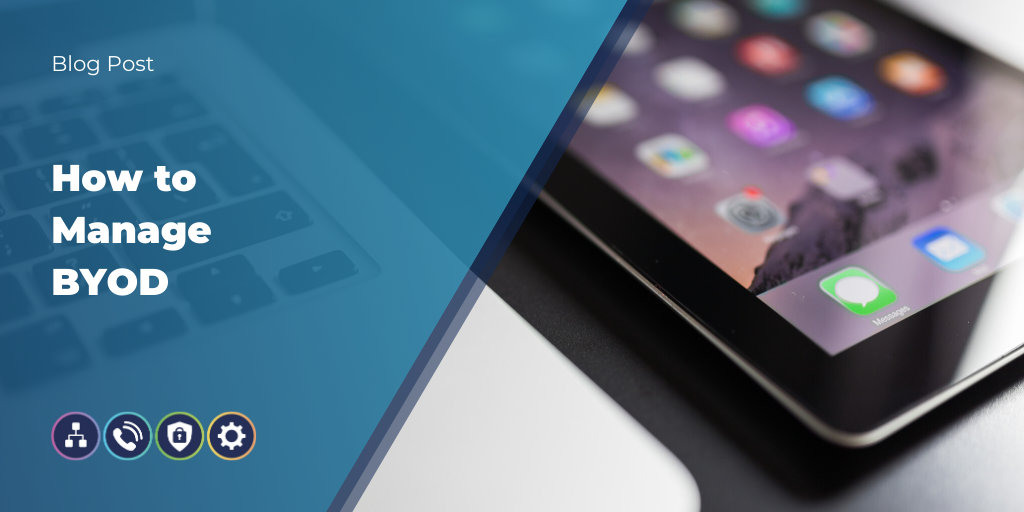Stay service-savvy
Get all the latest news and insights straight to your inbox.

Fast forward to 2020, and people’s attitudes are changing. Users have been told not to use their own devices, but they've done it anyway, and that's the most risky position you could be in. In response, many businesses have embraced the trend that's now named Bring Your Own Device.
If you haven’t considered BYOD, or implemented a strategy, you might soon find that your business is left behind. How long can you keep using that outdated hardware anyway? Is it really fit for purpose any more?
BYOD is an arrangement between the employee and the employer. It allows employees to use their own mobile devices: smartphones, tablets and laptops.
BYOD is usually arranged via a formal policy, which has to be signed by both parties at the start. The business usually requests that security software is installed, while the employee promises to lock their device using a PIN code, fingerprint or passphrase.
Straight away, we can see how BYOD would benefit the business instantly. It ensures every employee that needs a mobile device has one in their pocket, without the need to maintain pool equipment, or purchase large numbers of phones and laptops. It also means the business is more likely to benefit from the latest innovation, since people who choose their own hardware are more likely to upgrade every few years.
The business can also reduce its support for mobile devices. Users are generally familiar with their chosen operating system, and need less help achieving their aims. This ensures greater productivity, and a workforce that can actually get things done.
Right now, BYOD is usually offered as an optional arrangement, but that might be about to change.
According to Gartner, 38 per cent of companies expect that they will stop providing mobile devices, which will effectively force staff to use their own to get the job done. We could see a significant sea change in this area within the next 6-9 months.
Naturally, businesses are attracted BYOD because it lowers their procurement overheads. Some businesses have brought in BYOD while offering to contribute to the cost of the device, in exchange for a reasonable amount of access to it. Gartner now says few companies will foot the entire bill in future, but may pay up to half of the cost.
In fact, David Willis, the president of Gartner, suggests that they only pay for the mobile phone tariff, leaving the user to foot the bill for hardware.
If you’re thinking about rolling out BYOD, security should be your main focus. In the past, this has been the main stumbling block for businesses.
According to the UK Information Commissioner’s Office, we’re not taking data security seriously enough right now. Once you start allowing people to save and share corporate data on their own personal device, you simply must provide adequate training on the management of sensitive data.
Data protection rules in the EU are notoriously strict, and they have a very broad remit. They apply wherever an EU citizen’s data is saved or stored in the EU, and also when data is exported to a non-EU country. Over the next two years, your business needs to ensure it’s compliant with the new General Data Protection Regulation (GDPR), and that means training people not to leave unsecured devices lying around in public. An unsecured device left on the bar in a local nightclub could inadvertently open up personal data illegally, and the penalties are going to be severe.
Perhaps the best reason to encourage BYOD is because it will support your cloud migration objectives while keeping costs low. Let’s look at unified communications as an example.
Once you implement a hosted unified communications solution, you can place a hardware phone on every desk. Equally, you could require your users to install the relevant unified communications app(s) on their mobile devices.
Instantly, you have a completely connected workforce who can collaborate and communicate wherever they are. They can use their laptop, smartphone or tablet alongside the desk phones in the office, and seamlessly move between devices without missing a single call.
The beauty of unified communications is that it’s completely platform independent. Your users on iOS can talk to your users who have purchased Android phones. Your Windows users can video-conference with teams on a Mac. It supports BYOD, it makes everyone more productive, and it helps to cut costs.
If you’re looking ahead to a BYOD implementation, let Wavenet guide and support your business. Find out about our solutions today: just give us a call on 0333 234 0011.
Get all the latest news and insights straight to your inbox.